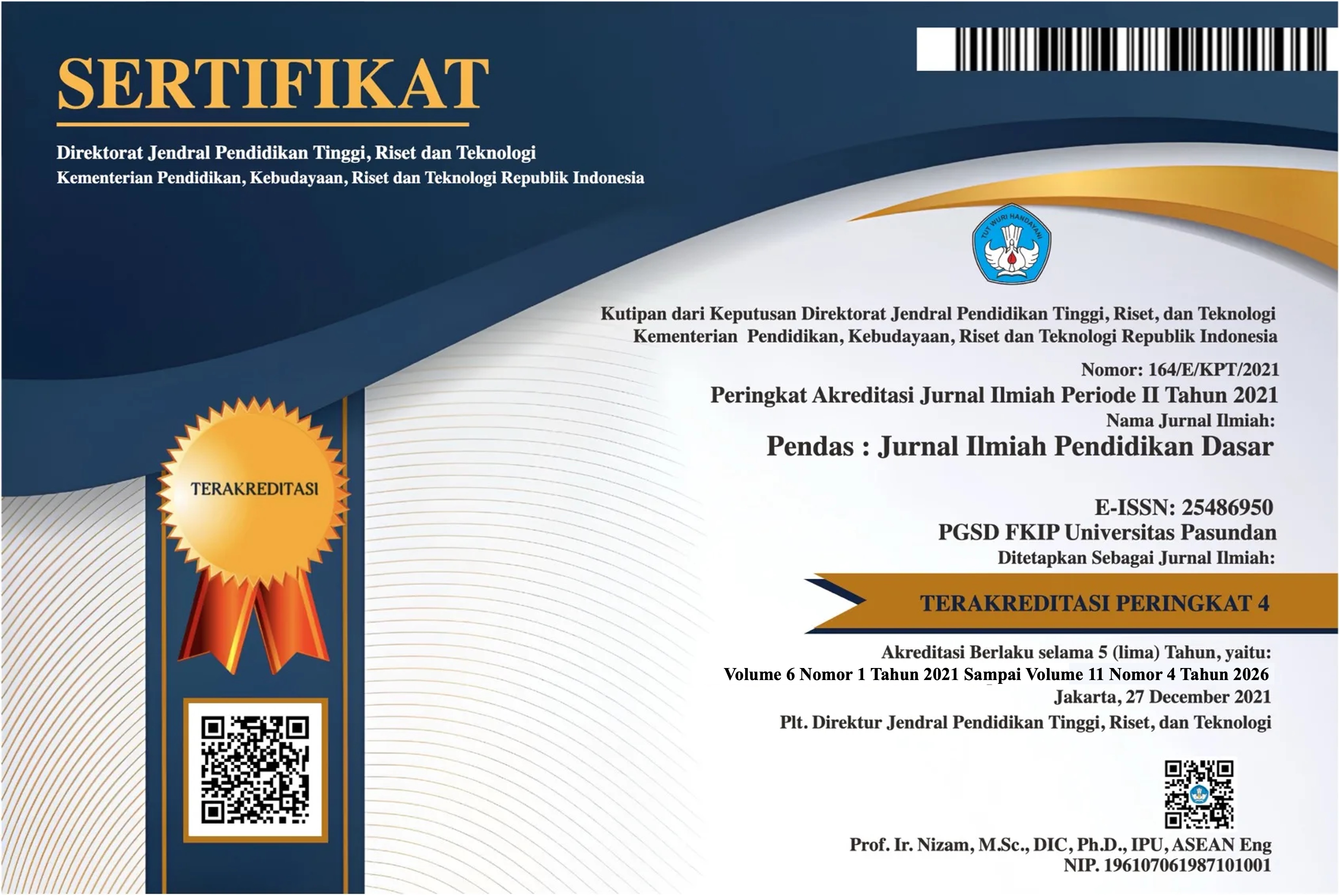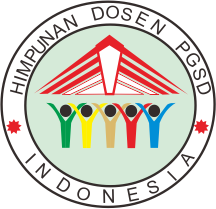STUDI LITERATUR: STRATEGI PEMBELAJARAN BAHASA INDONESIA BERBASIS LITERASI VISUAL DALAM MENGATASI KRISIS MINAT BACA SISWA SEKOLAH DASAR
DOI:
https://doi.org/10.23969/jp.v10i02.24118Keywords:
Visual Literacy, Reading Interest, Reading Skills, Indonesian Language LearningAbstract
The purpose of this study is to examine how visual literacy strategies to overcome the crisis of reading interest and reading skills of elementary school students. This research uses a Narrative Literature Review (NLR) approach to analyse various studies that discuss visual literacy and its impact on students' interest in reading in primary schools. He research findings show that visual literacy is very effective in Indonesian language learning, especially in overcoming the reading interest crisis that is commonly found in primary schools. The implementation of visual literacy allows students to learn more interactively, exploratively, and collaboratively, which in turn increases the overall effectiveness of learning. This research suggests that the implementation of visual literacy strategies in Indonesian language learning can be an effective solution to overcome the reading interest crisis in primary schools. By integrating visual media into educational practice, educators can create a more engaging and interactive learning environment that promotes literacy development and critical thinking. This approach not only addresses the issue of reading interest but also helps develop students' cognitive and analytical skills, which are essential for academic success and lifelong learning.
Downloads
References
Alalem, A. (2023). Digital storytelling for cultivating a participatory culture in first-year composition. Computers and Composition, 69, 102792. https://doi.org/10.1016/j.compcom.2023.102792
Alfatihah, D. F. N., & Tyas, P. A. (2022). The Correlation Between Undergraduate-Students’ Reading Interest and Their Reading Comprehension. Journal of Languages and Language Teaching, 10(3), 343. https://doi.org/10.33394/jollt.v10i3.5460
Anaktototy, K. (2023). Interplaying Reading and Writing in ESL/EFL: A Literature Review of Strategies for Indonesian Teachers. Elsya : Journal of English Language Studies, 5(1), 107–121. https://doi.org/10.31849/elsya.v5i1.9994
Angraini, D., Putra, W., Masurai, P., Wahyudi, L., & Firman. (2024). A Reading Teacher’s Perspective in Constructing the Students’ Critical Thinking. SALEE: Study of Applied Linguistics and English Education, 5(1), 290–305. https://doi.org/10.35961/salee.v5i1.1118
Bamgbose, A. A., Ibrahim, H. M., & Musa, S. (2024). Information Literacy and Learning in the Emerging Digital Landscape: a Theoretical Review. Library Philosophy and Practice, July, 1–22.
Belliza, A., & Kusumawati, N. (2024). The Influence of Visual Attributes in Packaging Design on Generation Z’s Dessert Snack Purchasing Decision. Journal of Consumer Studies and Applied Marketing, 2(1), 57–74. https://doi.org/10.58229/jcsam.v2i1.175
Bradley, L., Perry, M., Fassetta, G., Ryan, S. D., & Nelson, E. L. (2024). Denaturalizing “Intelligence” in Higher Education: AI as a Rupture to Imagining and Manifesting Sustainable and Anti‐colonial Literacies. Reading Research Quarterly, 59(4), 579–589. https://doi.org/10.1002/rrq.540
Ceyhan, S., & Yıldız, M. (2020). The effect of interactive reading aloud on student reading compre-hension, reading motivation and reading fluency*. International Electronic Journal of Elementary Education, 13(4), 421–431. https://doi.org/10.26822/iejee.2021.201
Chubb, J., Reed, D., & Cowling, P. (2024). Expert views about missing AI narratives: is there an AI story crisis? AI & SOCIETY, 39(3), 1107–1126. https://doi.org/10.1007/s00146-022-01548-2
Domínguez Romero, E., & Bobkina, J. (2021). Exploring critical and visual literacy needs in digital learning environments: The use of memes in the EFL/ESL university classroom. Thinking Skills and Creativity, 40, 100783. https://doi.org/10.1016/j.tsc.2020.100783
Ekowati, V. I., Nurhayati, E., Suwarna, S., & Saputri, I. I. (2023). Program for international student assessment-based analysis for Javanese test. International Journal of Evaluation and Research in Education (IJERE), 12(2), 1122. https://doi.org/10.11591/ijere.v12i2.24426
El-Sabagh, H. A. (2021). Adaptive e-learning environment based on learning styles and its impact on development students’ engagement. International Journal of Educational Technology in Higher Education, 18(1), 53. https://doi.org/10.1186/s41239-021-00289-4
Ferando, M. F., Bardi, Y., Kristianus, Y., Raja, F., Rada, M. M., Mude, M. R., Ngasu, P., Selviana, P., Pendidikan, I., Kewarganegaraan, P., Maumere, U. M., Pendidikan, I., Bahasa, P., & Maumere, U. M. (2025). Pemanfaatan Cerita Rakyat sebagai Media Penguatan Literasi Bahasa Indonesia budaya mereka . Berdasarkan laporan Programme for International Student Asesment ( PISA ) 2018 , Indonesia menempati peringkat yang cukup rendah dalam kemampuan. Fonologi: Jurnal Ilmuan Bahasa Dan Sastra Inggris, 3.
Fitria, T. N., & Simbolon, N. E. (2024). English Language Teaching ( ELT ) for Students with Visual-Spatial Learning Style Learning styles are usually identified. 5(02), 8–25.
Garcia-Varela, F., Bekerman, Z., Nussbaum, M., Mendoza, M., & Montero, J. (2025). Reducing interpretative ambiguity in an educational environment with ChatGPT. Computers & Education, 225, 105182. https://doi.org/10.1016/j.compedu.2024.105182
Hajizadeh, S., Ebadi, S., Salman, A. R., & Badiozaman, I. F. bt A. (2024). Young twins’ journey via digital storytelling towards multi-literacy development. Journal of Visual Literacy, 43(3), 214–232. https://doi.org/10.1080/1051144X.2024.2394333
Haleem, A., Javaid, M., Qadri, M. A., & Suman, R. (2022). Understanding the role of digital technologies in education: A review. Sustainable Operations and Computers, 3, 275–285. https://doi.org/10.1016/j.susoc.2022.05.004
Hamidah, S. W. (2023). INOVASI SEORANG GURU DALAM DUNIA PENDIDIKAN. https://doi.org/10.31237/osf.io/ue4fp
Hartoyo, I., Dew, N. R., Saragih, B., Isdianto, M. E., & Khairina, Y. (2024). Interactive Digital Flipbooks : Enhancing Engagement and Accessibility in Education for Diverse Learners in Technology in ELT Course at Universitas Negeri Medan. Sustainable, 7(2), 342–355.
Hossain, K. I. (2024). Literature-based language learning: Challenges, and opportunities for English learners. Ampersand, 13, 100201. https://doi.org/10.1016/j.amper.2024.100201
Houser, N., Spiers, J., Ross, J. J., & Kriellaars, D. (2024). SENSE-ational schools: physical literacy enriched opportunities for students with neurodiversity. Physical Education and Sport Pedagogy, 1–14. https://doi.org/10.1080/17408989.2024.2352824
Indrayadi, T. (2021). Indonesian EFL Learners’ Reading Motivation. IJELTAL (Indonesian Journal of English Language Teaching and Applied Linguistics), 5(2), 335. https://doi.org/10.21093/ijeltal.v5i2.745
Intiana, S. R. H., Prihartini, A. A., Handayani, F., Mar’i, M., & Faridi, K. (2023). Independent Curriculum and the Indonesian Language Education throughout the Era of Society 5.0: A Literature Review. AL-ISHLAH: Jurnal Pendidikan, 15(1), 911–921. https://doi.org/10.35445/alishlah.v15i1.3140
Irasuti, & Bachtiar. (2024). Empowering Indonesian EFL Teachers: The Transformative Impact of Visual Literacy Training on Teaching Materials. International Journal of Learning, Teaching and Educational Research, 23(8), 116–136. https://doi.org/10.26803/ijlter.23.8.7
Jaedun, A., Nurtanto, M., Mutohhari, F., Saputro, I. N., & Kholifah, N. (2024). Perceptions of vocational school students and teachers on the development of interpersonal skills towards Industry 5.0. Cogent Education, 11(1). https://doi.org/10.1080/2331186X.2024.2375184
Jais, N. M., Mustafa, H., Suraya, S., Jamaludin, S., Relevance, C., Use, I., & Opiate, A. O. (2021). Search 2021. SEARCH Journal of Media and Communication Research, June.
Kim, J., & Park, C. (2020). Education, skill training, and lifelong learning in the era of technological revolution: a review. Asian-Pacific Economic Literature, 34(2), 3–19. https://doi.org/10.1111/apel.12299
Krishna, S. M., & Agrawal, S. (2024). Creative Performance of Millennials and Generation Z: What Matters More, Intrinsic or Extrinsic Rewards? Administrative Sciences, 15(1), 11. https://doi.org/10.3390/admsci15010011
Laraswati, W., & Lidyasari, A. T. (2024). Revolutionizing Elementary Education: The Family Literacy Module - Boosting Reading Interest and Skills. AL-ISHLAH: Jurnal Pendidikan, 16(2). https://doi.org/10.35445/alishlah.v16i2.4699
Lestiyani, A. P., Riansi, E. S., & Email, C. (2024). Innovation in Learning Indonesian Language and Literature in the Digital Era : A Technological and Skills-Based Approach. International Conference of Nusantara Raya, 538–545.
Letters, F. O. F., & Examiners, B. O. F. (1945). The Impact of First Language “Negative Transfer” on EFL Learners’ Writing Proficiency The Case of Second Year LMD Students of English at the University of 8 Mai 1945, Guelma. June 2017.
Li, H., Majumdar, R., Chen, M.-R. A., & Ogata, H. (2021). Goal-oriented active learning (GOAL) system to promote reading engagement, self-directed learning behavior, and motivation in extensive reading. Computers & Education, 171, 104239. https://doi.org/10.1016/j.compedu.2021.104239
McGregor, H. E., Pind, J., & Karn, S. (2021). A ‘wicked problem’: rethinking history education in the Anthropocene. Rethinking History, 25(4), 483–507. https://doi.org/10.1080/13642529.2021.1992159
Meirbekov, A., Nyshanova, S., Meiirbekov, A., Kazykhankyzy, L., Burayeva, Z., & Abzhekenova, B. (2024). Digitisation of English language education: Instagram and TikTok online educational blogs and courses vs. traditional academic education. How to increase student motivation? Education and Information Technologies, 29(11), 13635–13662. https://doi.org/10.1007/s10639-023-12396-y
Mittal, U., Sai, S., Chamola, V., & Devika. (2024). A Comprehensive Review on Generative AI for Education. IEEE Access, September. https://doi.org/10.1109/ACCESS.2024.3468368
Muir, T., Wang, I., Trimble, A., Mainsbridge, C., & Douglas, T. (2022). Using Interactive Online Pedagogical Approaches to Promote Student Engagement. Education Sciences, 12(6), 415. https://doi.org/10.3390/educsci12060415
Mulei, H. (2023). Improving learners’ literacy competencies in early years education through children’s storybooks. Journal of Education, Curriculum and Teaching Studies ECTS, 4(1), 16–28.
Muthmainnah, Ganguli, S., Al Yakin, A., & Abd. Ghofur. (2023). An Effective Investigation on YIPe-Learning Based for Twenty-First Century Class (pp. 21–38). https://doi.org/10.1007/978-981-19-8967-4_2
Ng, D. T. K., Luo, W., Chan, H. M. Y., & Chu, S. K. W. (2022). Using digital story writing as a pedagogy to develop AI literacy among primary students. Computers and Education: Artificial Intelligence, 3, 100054. https://doi.org/10.1016/j.caeai.2022.100054
Nguyen, T. H. H., Ho, T. N., Do, T. M. D., & Pham, T. T. T. (2024). Factors Affecting Learner Autonomy in EMI Studying of English-Major Students at some Economics Universities in Hanoi, Vietnam. International Journal of Language Instruction, 3(3), 36–53. https://doi.org/10.54855/ijli.24333
Nugroho, R. S., & Widiatmojo, R. (2024). Exploring The Visual Literacy Parameters in English Elementary Textbooks by The Indonesian Ministry of Education and Culture. Proceedings of International Conference on Research in Education and Science, 10(1), 1631–1641.
Nurhayati, M. (2025). Jurnal Pendidikan Inovatif Jurnal Pendidikan Inovatif. Jurnal Pendidikan Inovatif, 6(April), 226–237.
Nuzulia, A. (1967). Enlightened Mind: Navigating the Nexus of Artificial Intelligence and Educational Mordernization. In Angewandte Chemie International Edition, 6(11), 951–952.
Park, C.-Y., & Kim, J. (2020). Education, Skill Training, and Lifelong Learning in the Era of Technological Revolution. SSRN Electronic Journal. https://doi.org/10.2139/ssrn.3590922
Ponomariovienė, J., & Jakavonytė-Staškuvienė, D. (2024). Solutions for Independent Goal Setting and Implementation of Primary School Students Fostering the Competence of Learning to Learn. Education Sciences, 14(4), 368. https://doi.org/10.3390/educsci14040368
Qorib, M. (2024). Analysis Of Differentiated Instruction As A Learning Solution In Student Diversity In Inclusive And Moderate Education. IJRS: International Journal Reglement & Society Analysis Of Differentiated Instruction As A Learning Solution …, 5(1), 43–55.
Romli, M., Sudiana, I. N., & Putrayasa, I. B. (2024). The Implementation of the ARCS Model in Indonesian Language Learning to Enhance Literacy Skills of Fifth-Grade Students at Elementary School. Jurnal Studi Guru Dan Pembelajaran, 7(3), 1421–1433. https://doi.org/10.30605/jsgp.7.3.2024.5101
Rosadi, A., & Purwokerto, U. M. (2022). Strategies to Teach English as a Foreign Language in Merdeka Curriculum : A Systematic Literature Review. 18. https://doi.org/10.30595/pssh.v18i.1278
Saepudin, S., Pabbajah, M. T. H., & Pabbajah, M. (2024). Unleashing the Power of Reading: Effective Strategies for Non-Native Arabic Language Learners. Alsinatuna, 9(2), 109–130. https://doi.org/10.28918/alsinatuna.v9i2.7826
Sayekti, O. M., Efendi, A., Sujarwo, S., Setyawan, H., Sunaryo, H., Sahabuddin, Sabariah, Rufi’i, Harmanto, Putro, B. N., Susanto, Zulbahri, & Pavlovic, R. (2024). Analyzing the role of motor skill training on critical reading ability in elementary school students. Retos, 61, 1101–1115. https://doi.org/10.47197/retos.v61.109633
Shofie Nurul Azizah, & Fahry Rizaldy Putra. (2024). Reframing A Self-Organized Learning Environment (SOLE) to Accommodate Indonesian EFL Students’ Learning Loss. Journal of Educational Learning and Innovation (ELIa), 4(1), 01–17. https://doi.org/10.46229/elia.v4i1.776
Sholikhah, M., Yuliasri, I., Fitriati, S. W., & Rusptipa, K. (2022). INTEGRATING THE DIGITAL MULTIMODAL PRESENTATION AND DIGITAL MULTIMODAL COMPOSITION IN ACADEMIC SPEAKING CLASS : IS IT WORTHWHILE ?
Styck, K. M., Malecki, C. K., Ogg, J., & Demaray, M. K. (2021). Measuring COVID-19-Related Stress Among 4th Through 12th Grade Students. School Psychology Review, 50(4), 530–545. https://doi.org/10.1080/2372966X.2020.1857658
Sulistyaningrum, D. (2024). Intended Publication: Journal’s Of Exploring Educational Competencies: A Comparative Analysis Of PISA And PIRLS Studies. International Journal of Science, Technology & Management, 5(2), 395–404.
Tang, K. (2024). Informing research on generative artificial intelligence from a language and literacy perspective: A meta‐synthesis of studies in science education. Science Education, 108(5), 1329–1355. https://doi.org/10.1002/sce.21875
Taye, T., & Mengesha, M. (2024). Identifying and analyzing common English writing challenges among regular undergraduate students. Heliyon, 10(17), e36876. https://doi.org/10.1016/j.heliyon.2024.e36876
Triventi, M., Vlach, E., & Pini, E. (2022). Understanding why immigrant children underperform: evidence from Italian compulsory education. Journal of Ethnic and Migration Studies, 48(10), 2324–2346. https://doi.org/10.1080/1369183X.2021.1935656
Ulkhaq, M. M. (2024). Factors Influencing Indonesian Students ’ Performance on PISA 2018. Proceeding of The International Conference of Inovation, Science, Technology, Education, Children, and Health, 4(1), 74–87.
Wisnu Budi Wijaya, I. K., Made Ayu Suryaningsih, N., Ayu Astiti, K., Endah Poerwati, C., & Syahputra, A. (2024). Socio Scientific Issue (SS1) Approach as a Momentum to Instill Cultural Literacy and Scientific Literacy Through Natural Science Learning. Jurnal Pendidikan MIPA, 25(2), 972–985. https://doi.org/10.23960/jpmipa/v25i2.pp972-985
Xu, J., Pan, Y., & Derakhshan, A. (2024). The Interrelationships Between Chinese English-as-a-Foreign-Language Teachers’ Immediacy and Clarity with Learners’ Boredom. Perceptual and Motor Skills, 131(5), 1934–1957. https://doi.org/10.1177/00315125241272524
Yunus, M., Dalle, M. B., Kaharuddin, K., Hudriati, A., & Strid, J. E. (2024). Enhancing Paragraph Writing Proficiency: A Study of Students’ Performance Post Global English Textbooks Exposure. International Journal of Language Education, 8(1). https://doi.org/10.26858/ijole.v8i1.60913
Yunus, M., & Ubaidillah, M. F. (2021). EFL teacher educators’ experiences in teaching critical reading: evidence from Indonesia. Journal on English as a Foreign Language, 11(2), 422–441. https://doi.org/10.23971/jefl.v11i2.3133
Zen, Z., Reflianto, Syamsuar, & Ariani, F. (2022). Academic achievement: the effect of project-based online learning method and student engagement. Heliyon, 8(11), e11509. https://doi.org/10.1016/j.heliyon.2022.e11509
Zhang, H., Meng, F., Li, X., Ning, Y., & Cai, M. (2021). Social listening – revealing Parkinson’s disease over day and night. BMC Neurology, 21(1), 2. https://doi.org/10.1186/s12883-020-02024-4
Downloads
Published
Issue
Section
License
Copyright (c) 2025 Pendas : Jurnal Ilmiah Pendidikan Dasar

This work is licensed under a Creative Commons Attribution 4.0 International License.



















